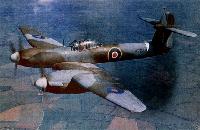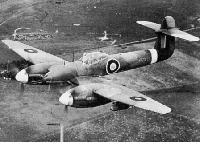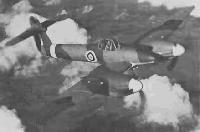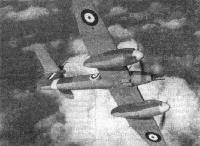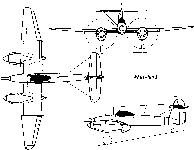
Whirlwind
Двухмоторный одноместный истребитель, цельнометаллический моноплан с закрытой кабиной и убирающимся шасси. Спроектирован в КБ фирмы "Уэстленд эйркрафт" под руководством У.Петтера. Первый полет опытный образец истребителя совершил 11 октября 1938 г. Серийное производство началось на заводе "Уэстленд" в Йовиле с июня 1940 г. Всего выпущено 114 самолетов. Самолет состоял на вооружении только в Великобритании. Моторы "Переграйн", вооружение 4x20, бомбы до 450 кг. Применялся как дальний истребитель для прикрытия кораблей в открытом море с января 1941 г., с июня - для рейдов на континент, в т.ч. и как истребитель-бомбардировщик. Снят с производства в январе 1942 г., с вооружения - в ноябре 1943 г.
"Уирлуинд" I||
Размах:||13,7 м
Длина:||9,83 м
Моторы, количество х мощность:||2x885 л.с.
Взлетная масса, максимальная:||5165 кг
Максимальная скорость:||579 км/ч
Практический потолок:||9150 м
Дальность:||1000 км
Описание:
- Whirlwind
- Westland Whirlwind
Фотографии
-
Авиация и Космонавтика 1996-05 / В.Катков - Опоздавший "Вихрь"
Регистрационный номер: L6844 [7] Первый прототип истребителя "Уирлуинд". 1938г.
-
Авиация и Космонавтика 1996-05 / В.Катков - Опоздавший "Вихрь"
Регистрационный номер: P6984 [3] "Уирлуинд" Mk.I из 236-й эскадрильи. Январь 1941г.
-
Мировая Авиация 54
Регистрационный номер: P6969 [2] Первый специально разработанный по требованиям британских ВВС двухмоторный истребитель Westland Whirlwind поступил в эксплуатацию в 263-ю эскадрилью в июне 1940 года, а в сентябре того же года - в 137-ю эскадрилью. Обладая отличными летными качествами на малых высотах, Whirlwind оказался неэффективным на большой высоте. Его использование постепенно ограничилось решением задач легкого маловысотного бомбардировщика.
-
Air Enthusiast 1971-10 / R.Braybrook - Trial by Fire /Fighters in the RAF/ (2)
Регистрационный номер: P6969 [2] Whirlwind (P6969) of No 263 Sqdn, Winter 1941-2.
-
Авиация и Космонавтика 1996-05 / В.Катков - Опоздавший "Вихрь"
Регистрационный номер: P7095 "Уирлуинд" Mk.I из 137-й эскадрильи. Декабрь 1942г.
-
Авиация и Космонавтика 1996-05 / В.Катков - Опоздавший "Вихрь"
Регистрационный номер: G-AGOI [2] "Уирлуинд" Mk.I, использовавшийся фирмой Вестланд в 1946-47гг.
-
Мировая Авиация 251
Регистрационный номер: P7048 [5] Whirlwind стал первым одноместным двухмоторным истребителем британских ВВС и сочетал превосходную маневренность, высокую огневую мощь и высокую скорость на малой высоте.
-
Aeroplane Monthly 1974-11 / Westland Whirlwind /Press Debut/
Регистрационный номер: P7048 [5] Westland Whirlwind F.Mk 1 P7048, photographed during the war by Charles E. Brown. As G-AGOI it later became the only Whirlwind in the civil register, finally being dismantled in 1947.
-
Air Enthusiast 1973-07 / ??? - Whirlwind ... first of the four-cannon fighters /Warbirds/
Регистрационный номер: L6844 [7] The first prototype. Note also in this picture the exhaust stubs on the wing trailing edge, radiator outlet, mudguards (later discarded) and original rudder.
-
Aeroplane Monthly 1985-01 / T.Heffernan - Something special from Somerset (1)
Регистрационный номер: L6844 [7] The prototype Whirlwind photographed at Boscombe Down in October 1938 shortly after it had been reassembled prior to its maiden flight, having been transported from Yeovil by lorry.
Designated by Westland as the P.9, the prototype, L6844, sits outside the hangar at Boscombe Down before its first flight, in the hands of Westland’s chief test pilot, Harald Penrose, on October 11, 1938. Note the absence of the "bullet" fairing at the fin/tailplane junction later added to the aircraft, and all subsequent examples, to cure tail buffet. -
Aeroplane Monthly 1985-01 / T.Heffernan - Something special from Somerset (1)
Регистрационный номер: L6844 [7] 11 октября 1938г.: поднялся в воздух прототип Westland Whirlwind (L6844), первый одноместный двухмоторный истребитель британских ВВС.
Photograph of the prototype Westland Whirlwind, L6844, taken in October 1938 at Yeovil. On October 11 Harald Penrose made the first flight in this aircraft, from Boscombe Down, and three days later took L6844 to Yeovil. -
Aeroplane Monthly 1985-01 / T.Heffernan - Something special from Somerset (1)
Регистрационный номер: L6844 [7] Photograph of the prototype Westland Whirlwind, L6844, taken in October 1938 at Yeovil. On October 11 Harald Penrose made the first flight in this aircraft, from Boscombe Down, and three days later took L6844 to Yeovil.
-
Air Enthusiast 1973-07 / ??? - Whirlwind ... first of the four-cannon fighters /Warbirds/
Регистрационный номер: L6845 [7] The second Whirlwind prototype, with enlarged rudder and small fin tailplane fairing - this was enlarged for production aircraft
-
Aeroplane Monthly 1985-01 / T.Heffernan - Something special from Somerset (1)
Регистрационный номер: L6845 [7] -
Aeroplane Monthly 1985-01 / T.Heffernan - Something special from Somerset (1)
Регистрационный номер: L6845 [7] View of the second prototype Westland Whirlwind photographed at Martlesham Heath, probably in July 1939. Note the “saxophone" exhausts.
-
Aviation Historian 20 / M.Bearman - The Whirlwind becalmed
Регистрационный номер: L6845 [7] The second prototype at Martlesham Heath while undergoing acceptance trials. The Whirlwind was designed to meet Specification F.37/35, Britain’s first for a four-cannon fighter. Five of the eight manufacturers invited to tender responded, Boulton Paul and Hawker with single-engined designs and Bristol, Westland and Supermarine with twins.
-
Авиация и Космонавтика 1996-05 / В.Катков - Опоздавший "Вихрь"
Регистрационный номер: L6845 [7] Второй прототип P.9. Хорошо видны выпущенные закрылки, отклоненные вместе с обтекателем мотогондолы
-
Aviation Historian 20 / M.Bearman - The Whirlwind becalmed
Регистрационный номер: L6845 [7] A close-up of the experimental Roto I propeller blades fitted to L6845, but, significantly, not to production machines. Why L6845 was tested with these and not production D.H. props remains unclear. As a result the data acquired during trials was skewed.
-
Aviation Historian 20 / M.Bearman - The Whirlwind becalmed
Регистрационный номер: L6845 [7] The second prototype Whirlwind, L6845, was tested with propellers of a one-off Rotol design, as seen fitted here. The first prototype, L6844, had been fitted with “handed” Peregrines driving de Havilland propellers, but the props of L6845 rotated in the same direction, the two aircraft sharing broadly similar handling characteristics.
-
Air Enthusiast 1973-07 / ??? - Whirlwind ... first of the four-cannon fighters /Warbirds/
Регистрационный номер: L6844 [7] The prototype L6844 after modification to production standard, with no mudguards, enlarged rudder and external exhausts, but with an experimental arrangement of the four cannon line-abreast in the nose.
-
Air Enthusiast 1973-07 / ??? - Whirlwind ... first of the four-cannon fighters /Warbirds/
Регистрационный номер: L6844 [7] The prototype L6844 with a 37-mm cannon in the nose.
-
Aviation Historian 20 / M.Bearman - The Whirlwind becalmed
Регистрационный номер: P6966 The first two production Whirlwinds, P6966 (seen here) and P6967, were originally delivered to No 25 Sqn at North Weald in June 1940 for night-flying trials; but the unit was equipped with Bristol Beaufighters instead, and the two aircraft were reallocated to the first Whirlwind unit, No 263 Sqn, at Grangemouth.
-
Aviation Historian 36 / M.Russell - A question of calibre
By the time Air Ministry Specification F.37/35 was issued in 1935, it had been recognised that striking power superior to the eight-gun armament specified in F.5/34 was worth investigating. This led ultimately to the Westland Whirlwind, fitted with four fixed Hispano 20mm cannon concentrated in the nose, as seen here.
-
Aviation Historian 35
Регистрационный номер: P6984 [3] Positively bristling: Westland Whirlwind P6984 of No 263 Sqn shows off its four nose-mounted 20mm cannon.
The standard de Havilland 54409 propeller blades fitted to production Whirlwinds are seen here on P6984 of No 263 Sqn. The D.H. props were considerably thicker than those used on L6845; a fact which significantly affected the type’s performance. -
Мировая Авиация 59
"Беелоуз Аргентина" - самолет "Уирлуинд" I, построенный на средства, собранные в Южной Америке, январь 1942 г. Этот самолет принадлежал 263-й истребительной эскадрилье, которая базировалась на авиабазе Уормвелл и участвовала в налетах на немецкие объекты во Франции.
-
Авиация и Космонавтика 1996-05 / В.Катков - Опоздавший "Вихрь"
Регистрационный номер: P6984 [3] -
Air-Britain Aeromilitaria 1980-01
Регистрационный номер: P7055 [2] Whirlwind I P7055 of No.137 Squadron at Mansion in March 1943.
-
Aeroplane Monthly 1985-02 / T.Heffernan - Something special from Somerset (2)
Регистрационный номер: P7055 [2] Whirlwind P7055 of 137 Sqn rests between sorties. It was struck off RAF charge in September 1944.
-
Авиация и Космонавтика 1996-05 / В.Катков - Опоздавший "Вихрь"
"Уирлуинд" из 173-й эскадрильи. Наземный персонал подвешивает под крыло самолета 113-кг бомбу
-
Aeroplane Monthly 1985-02 / T.Heffernan - Something special from Somerset (2)
A 137 Sqn Whirlwind about to be bombed up with 250lb bombs. Whirlwinds could carry a 1,000lb bomb load and fighter bombers were equipped with Mk III Universal bomb carriers for that purpose.
-
Aviation Historian 20 / M.Bearman - The Whirlwind becalmed
Only two squadrons - Nos 253 and 137 - flew the Whirlwind operationally, the type’s last sortie being performed by the former on November 29, 1943, but not before the aircraft had proved itself a highly capable ground-attacker; bomb-equipped examples, as seen here, were dubbed “Whirlibombers”.
-
Aeroplane Monthly 1985-02 / T.Heffernan - Something special from Somerset (2)
Loading a 250lb bomb onto the Mk III Universal carrier on a 137 Sqn Whirlwind.
-
Aviation Historian 2 / J.Wood - The Lion and its Claws
Регистрационный номер: P6971 Whirlwinds fitted with bombs were unofficially dubbed “Whirlibombers”, an example of which, P6971, is seen here in October 1943 at the unit’s base at Warmwell in Dorset, from where the pugnacious twin-engined fighter-bombers would attack enemy shipping and airfields. That December the unit re-equipped with Typhoons.
-
Авиация и Космонавтика 1996-05 / В.Катков - Опоздавший "Вихрь"
"Уирлуинд" в укрытии на аэродроме Дрем (октябрь 1940г.)
-
Aviation Historian 20 / M.Bearman - The Whirlwind becalmed
The Whirlwind’s ingeniously devised oil-cooler intakes were incorporated into the wing centre section, as seen here. Cooling air would enter via these "letterbox" intakes in the leading edge and be ducted through the spar to the three-element radiators buried within the centre section.
-
Авиация и Космонавтика 1996-05 / В.Катков - Опоздавший "Вихрь"
"Уирлуинд" из 263-й эскадрильи перед боевым вылетом. Аэродром Эксетер (декабрь 1940г.)
-
Aeroplane Monthly 1985-01 / T.Heffernan - Something special from Somerset (1)
The Whirlwind's sting. The four 20mm Hispano cannon and the ammunition drums are revealed in the picture at right. The projection beneath the wing carried a 16mm cine camera.
-
Aeroplane Monthly 1985-02 / T.Heffernan - Something special from Somerset (2)
Armourers attending to a 137 Sqn Whirlwind. The character dangling over the four 20mm Hispano cannon has obviously been told to look busy!
-
Авиация и Космонавтика 1996-05 / В.Катков - Опоздавший "Вихрь"
Командир 263-й эскадрильи Джон Монро у своего самолета
-
Aviation Historian 2 / J.Wood - The Lion and its Claws
Flight Sergeant Harvey beside the tail of a 263 Sqn Whirlwind;
-
Aviation Historian 2 / J.Wood - The Lion and its Claws
A posed photograph of 263 Sqn pilots, probably taken by a professional photographer sent to take official portraits of squadron members.
-
Aeroplane Monthly 1985-02 / T.Heffernan - Something special from Somerset (2)
Регистрационный номер: P7002 A happy group photograph of 137 Sqn aircrew. Whirlwind P7002 in the background was ditched off Deal in April 1943.
Correspondent J. B. Wray identifies the aircrew in the picture as follows (left to right): Plt Off Luing; Fg Off Musgrave (Australian); Flt Sgt Roberts; Sgt Barclay; Flt Lt Bryan; Plt Off de Houx (Canadian); Sgt Smith; Plt Off McClure (Canadian); unidentified; Sgt Sutherland; unidentified; unidentified; Sqn Ldr Coghlan (CO); Sgt O'Neill; Flt Sgt Woodhouse. The dog in front of them is the squadron mascot, Lynne. -
Air Enthusiast 1973-07 / ??? - Whirlwind ... first of the four-cannon fighters /Warbirds/
A close-up of the Fowler flaps, showing how they were continuous across the fuselage and had attached to them the rear fairings of the nacelles.
-
Aeroplane Monthly 1974-11 / Westland Whirlwind /Press Debut/
Регистрационный номер: P7110 [3] -
Aviation Historian 20 / M.Bearman - The Whirlwind becalmed
Регистрационный номер: P7110 [3] Whirlwind P7110 served with 263 Sqn. It crashed in an attempted forced landing near Warmwell in July 1943.
Harald Penrose at the controls of Whirlwind P7110 in September 1941, by which time the aircraft had begun establishing a reputation as an exceptional weapon for lower-altitude duties, including ground-attack and intercepting low-level enemy intruders. This machine was written off during a forced landing near Warmwell, Dorset, in July 1943. -
Aeroplane Monthly 1981-01 / D.Middleton - Harald Penrose /Test Pilot Profile/ (2)
Регистрационный номер: P7112 [2] Penrose made the first flight of the Westland Whirlwind in October 1938.
The Westland Whirlwind was designed to Air Ministry Specification F.37/35, issued in February 1936, for a cannon-armed single-seat day- and night-fighter predominantly for home defence, and had speed and fierce firepower at the heart of its design; the four 20mm cannon in the nose were for knocking down unescorted bombers. -
Aeroplane Monthly 1985-01 / T.Heffernan - Something special from Somerset (1)
Регистрационный номер: P7048 [5] Whirlwind I P7048 initially flew with 137 Squadron but after the war was civilianised by Westland.
-
Aviation Historian 35 / M.Bearman - The other sound barrier
Регистрационный номер: P7048 [5] In his article in TAH20, The Whirlwind Becalmed, the author explained how the second Whirlwind prototype, L6845, was fitted with experimental Rotol propellers for trials at the A&AEE, giving notably better performance than the thicker de Havilland propellers fitted to production machines such as P7048, seen here.
-
Aeroplane Monthly 1985-02 / T.Heffernan - Something special from Somerset (2)
Регистрационный номер: P7112 [2] Whirlwind I P7112 poses for Flight’s cameraman in September 1941. This particular aircraft flew with 263 Sqn.
-
Air Enthusiast 1973-07 / ??? - Whirlwind ... first of the four-cannon fighters /Warbirds/
Регистрационный номер: P6997 [2] A production Whirlwind after modification to carry underwing bombs.
-
Мировая Авиация 54
Регистрационный номер: P6997 [2] Днем на малой высоте Whirlwind почти не имел себе равных по скорости и вооружению. Самолет на фотографии несет под каждой плоскостью по одной бомбе калибра 113 кг.
-
Aeroplane Monthly 1985-01 / T.Heffernan - Something special from Somerset (1)
Регистрационный номер: P7048 [5] Another view of the Whirlwind I P7048. After service with 137 Squadron this aircraft was civilianised by Westland and given the civil registration G-AGOI. It was dismantled at Yeovil in May 1947.
-
Air Enthusiast 1973-07 / ??? - Whirlwind ... first of the four-cannon fighters /Warbirds/
Регистрационный номер: P7062 [2] Whirlwind P7062 of 263 Squadron hit trees during a practice attack at Wroughton in May 1943.
-
Air Enthusiast 1973-07 / ??? - Whirlwind ... first of the four-cannon fighters /Warbirds/
Регистрационный номер: P7062 [2] -
Jane's All the World Aircraft 1980 / Encyclopedia of Aviation - Aircraft A-Z - v5
Westland Whirlwind I, powered by two 660 kW (885 hp) Rolls-Royce Peregrine I engines. Of 200 ordered for the RAF, only 112 were delivered, first becoming operational as long-range fighters and fighter-bombers in late 1940. Maximum speed was 579 km/h (360 mph).
-
Aviation Historian 29 / G.Baughen - 1939. Was the RAF ready to war?
Регистрационный номер: P7110 [3] Истребитель Уэстленд "Уирлуинд" в полете
A revealing study of Whirlwind I P7110, showing perfectly one of the aircraft ’s total blind spots. This aircraft crashed during a forced landing at Warmwell in July 1943 while on the strength of 263 Sqn.
Designed to Air Ministry Specification F.37/35, the Westland Whirlwind was the first single-seat twin-engined fighter to see RAF service, the first production examples being delivered to No 263 Sqn at Exeter in December 1940. The type’s four fixed forward-firing 20mm cannon in the nose offered an excellent concentration of considerable firepower, although it never quite overcame early teething troubles and was later used in the fighter-bomber role. -
Моделист-Конструктор Истребители Второй мировой войны
Истребитель "Уирлуинд" I в полете
-
Aeroplane Monthly 1985-02 / T.Heffernan - Something special from Somerset (2)
Whirlwind with everything dangling on demonstration to Flight’s photographer. Westland test pilot Harald Penrose is the pilot.
-
Air Enthusiast 1973-07 / ??? - Whirlwind ... first of the four-cannon fighters /Warbirds/
Регистрационный номер: G-AGOI [2] The last Whirlwind to remain airworthy - and that only until May 1947 - was registered G-AGOI for use as a company "hack ” by Westland, having previously been P7048.
-
Aviation Historian 2 / J.Wood - The Lion and its Claws
Flight Lieutenant David G. “Bill” Ross, an RAF Volunteer Reserve pilot who flew Whirlwinds with 263 Sqn. He was killed on May 2, 1942, while serving with another unit, reportedly having taken off in a Spitfire from Great Sampford after polishing off ten bottles of Benskins Colne beer with his CO, Sqn Ldr Gilbert, who was also killed.
-
Aeroplane Monthly 1977-11 / H.Best-Devereux - Oshkosh Silver Jubilee
Регистрационный номер: N50GB Yet another scaled-down Second World War aircraft on show was this two-thirds scale Westland Whirlwind. Powered by two 1600cc VW engines and built of aluminium, it was completed just in time for Oshkosh and was not flown.
-
Aeroplane Monthly 1985-01 / T.Heffernan - Something special from Somerset (1)
Кабина самолета P.9
The all-round view from the well-appointed Whirlwind cockpit was good, though the seat was considered to be uncomfortable. -
Aeroplane Monthly 1983-10
Регистрационный номер: R7005 The photograph is one of several passed on to A. R. Chapman by a German officer involved in the recovery of Whirlwind SF-H (R7005) in January 1943 near Reims.
-
Air Enthusiast 1973-07 / ??? - Whirlwind ... first of the four-cannon fighters /Warbirds/
A model of the Westland F.37/25 fighter as it was in the Autumn of 1937. All the characteristic features of the Whirlwind design are obvious apart from the single tail unit.
-
Aeroplane Monthly 1988-11
First flight of the Westland Whirlwind: October 11, 1938
- Фотографии






